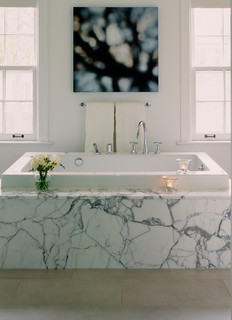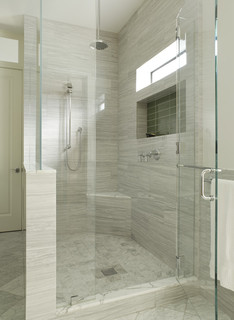9 Hard Questions to Ask When Shopping for Stone
 Thursday, December 19, 2013 at 10:01AM
Thursday, December 19, 2013 at 10:01AM Article by: Anne Higuera CGR, CAPS
Deciding to use stone and choosing the kind to use are more complicated than just picking a finish you like. Because stone is a natural material, its appearance, durability and production can vary from one quarry to another, and from one batch to another, causing problems (or in some cases, providing benefits) you might not have anticipated.
Here are nine questions you should consider before buying stone.
How thick does it need to be? Floor and wall tiles for interiors are usually ⅜ inch thick, while countertop slabs are typically 2 centimeters (¾ inch) or 3 centimeters (1¼ inches) thick. Exterior stone pavers could be 1½ inches or thicker.
Differences in counter and paver thicknesses can usually be accommodated if planned for in advance. It’s also not unusual to add a laminated edge to the front of a 2-centimeter counter to make it appear thicker. Tile for floors, however, can be tricky, particularly if you want your floor to flow to adjacent rooms without a transition. The best practice is to select floor tile early in the process and choose a material with consistent thickness.
We opened a box of specified slate tile on a project and discovered that each piece was a different thickness, with some well over ½ inch, making them higher than the adjacent wood floors even without thinset below. The clients opted to send it all back and ended up selecting a ceramic tile with similar colors but very consistent thickness.
Are there fissures? This is a question not just for countertop slabs but for tiles, as well. A fissure is a natural weak point in the stone, usually visible as a hairline crack. A fissure’s location can prevent you from using the stone if cuts will result in the weakest point’s being located where the stone needs to be strong, like around a sink or on an overhang. It can also result in the slab’s breaking during fabrication.
Fragile stone tile can also break during cutting, which means tile setters have to anticipate more waste. Instead of ordering the usual 5 to 10 percent extra for waste, they might add 15 to 20 percent more. The best practice is to select a slab and have the fabricator review it for flaws and fissures, so that you’ll have time to select something else if it won’t work.
What’s your finish? The most common finishes for stone are polished and honed. Both have a sheen, although honed has a fine texture that minimizes reflection. A heavier texture can be achieved with acids, buffing and heat, resulting in “antiqued,” “tumbled”and “flamed” finishes. Which one you choose depends upon personal taste, except when it comes to matters of safety. The larger the tile and the more polished the finish, the more likely it will be slippery under wet feet or shoes.
An easy way around slipperiness is to install the material in a smaller size — 4 inches square or less — or to select a material with more texture.
How well will samples match what arrives at your home? Because stone is a natural material, it can vary in color and in many other ways. If you can, get a large sampling of what’s in stock — five to 10 pieces of 12- by 12-inch tiles, for example — so you can see what you’re likely to get in a typical box. If there’s a huge variation in color or quality, you may want to look at something else.
This backsplash (far end) is a mix of onyx and glass mosaic tile. The onyx tile arrived at the jobsite with some bright red streaks across the face, which weren’t visible in the sample. The clients opted to buy additional tile and piece in nonred stone to make the results more consistent.
Is it strong enough to span? Countertops are sometimes designed to span significant distances — over dishwashers, breakfast bars and desks, for example. Manufactured materials like quartz have specific maximum spans, but the fabricator may recommend a variety of solutions with stone, depending upon how large the unsupported portion is: a decorative corbel or other support; a concealed steel brace; or even a routed area under the stone for a steel or fiberglass rod. Your fabricator will help you determine how much support your counter needs.
How porous is it? All stone is not created equal. Some stones, such as limestone and marble, are more porous than others, and are more likely to absorb stains from substances like red wine and coffee. Acidic substances like lemons can etch surfaces, and even hair dye can stain a shower. Some stones, such as soapstone, are softer than others and can be scratched.
Before committing to a stone, think carefully about how you plan to use it, and how much contact it’ll have with potentially damaging substances.
Will it hold up? The answer to this question depends on your lifestyle, how much you plan to use the stone surface and how careful you are with cleaning. (Cleaning products can etch limestone, marble and other materials.)
We once had clients whose old limestone counters were covered in coffee stains and had to be removed. They replaced them with Caesarstone, which remains in great shape many years later. My own granite counters are pristine almost a decade after installation, with no resealing.
To seal or not to seal? Sealants are frequently used on grout and sometimes on natural stone.Some sealants darken or even give a shiny look to otherwise honed or textured surfaces. If you’re considering a sealant for your stone, request a sample showing you different options, so you’ll know how the finished surface will look.
What’s the source? Stone comes from quarries across the globe, including the United States. Part of selecting a material involves thinking about where it comes from, how it is produced, the environmental impact of transporting it to your locality, and whether it is a sustainable, sensible and long-lasting material.
If you still have questions, ask your local supplier, fabricator, contractor or designer about the specifics for your project.






























